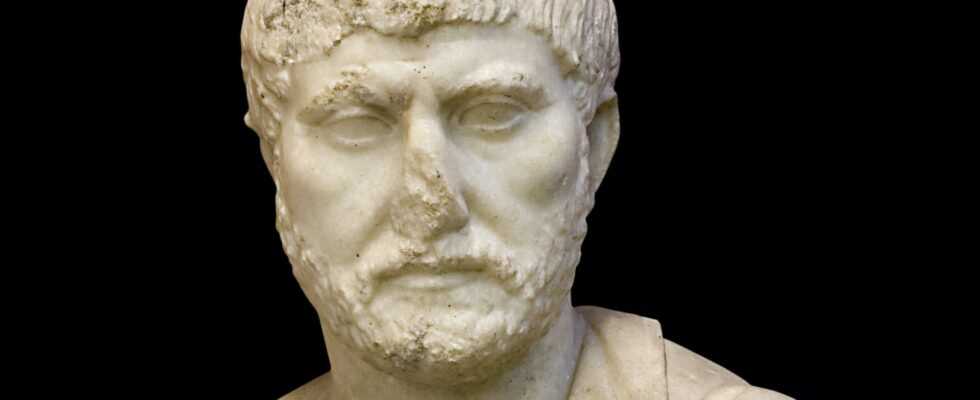The Roman administrators and governors of Judea were also allowed to mint their own small bronze coins in the name of the emperor. Such coins have survived from the time of Pontius Pilate, but not from the tenure of Claudius Paternus Clementianus. Otherwise, Paternus’ administrative activity in Judea is not documented by local inscriptions.
The final stages of Paternus’ career
The same applies to his subsequent governorships in the provinces of Sardinia et Corsica – from 115 to 119 – and Africa – from 119 to 122. By Africa was meant the province that had emerged from the ruined empire of Carthage. East Algeria, Tunisia and West Libya (Tripolitania) are located there today. For the last station in Paternus’ career, the source situation looks much better. The fact that he was procurator in Noricum from about 122 to 125 is no longer preserved on his “career stone”, but evidence of his work was found in this province.
© courtesy of the Carinthian State Museum (detail)
Claudius Paternus Clementianus | When he took over the governorship in Noricum in 122, Paternus had the temple of the goddess Noreia renovated. In the remains of the sanctuary, experts discovered this portrait bust of an elderly bearded man. Stylistically, it belongs to the time of Paternus and may also represent the procurator.
Similar to Judea, Noricum was initially an area with limited autonomy, tributary to the Roman Empire – except that the Romanization here was probably more peaceful and apparently supported by the local population. Emperor Claudius declared Noricum to be a Roman province, whose areas today encompassed roughly the south-east of Bavaria (Chiemgau), parts of Tyrol and above all the present-day Austrian federal states of Salzburg, Carinthia, Styria and Lower and Upper Austria. The province was subordinate to equestrian procurators, such as Paternus was.
It is possible that his descent from the neighboring province of Raetia and his Celtic roots were advantageous for his appointment as Noric governor. Because many of the around 30 holders of this office who are known by name so far can be assigned to regions of origin, especially in northern Italy and the Alpine provinces. Good relations with the local population were probably helpful for this post.
Paternus sponsored the temple to Noreia
Emperor Claudius had already made Virunum in today’s Carinthia the provincial capital and the seat of the governor. Paternus also had buildings erected there during his service. At least we know of a fragmentary building inscription that belonged to the temple of the Celtic-Roman goddess Noreia. According to numerous statues and votive offerings, she may have been the main deity in the region. Epigraphists deciphered and supplemented the following text on Paternus’ inscription:
[Noreia Au]g(ustae) sacrum
Sabi[nius … b(ene)f(iciarius) … Cl]audi(i) Paterni Clementiani proc(uratoris) Aug(usti)
a [solo restituit cel]lam columnas pavimenta porticum.
According to this, a »beneficiarius«, i.e. a dignitary named Sabi, entrusted with police duties and subordinate to the governor Paternus appears[nius] to have renewed the Holy of Holies (cella), the columns (columnae), the plaster (pavimenta) and the entrance (porticus) of the sanctuary with a dedication to his employer. The supplemented name Sabinius can be considered largely certain, since the Sabinii family is repeatedly occupied as mayor in Virunum.
In addition, archaeologists found a life-size portrait bust in the Noreia temple, which probably represented none other than Paternus himself. Stylistically, experts date it to the time of Emperor Hadrian, who reigned from 117 to 138. The portrait shows an elderly man with a wrinkled face and beard. A coat is draped over the left shoulder of the naked upper body, which is held together by a disc brooch. The well-worked portrait is probably the work of an Italian sculptor.
It is not possible to determine how long Paternus lived after he had posed for his impressive old age portrait. In any case, after his service in Noricum he returned as a veteran to his Rhaetian homeland in Abodiacum, where he probably died around the year 130. Paternus had been on the road in the Roman Empire as a military man and civil servant for decades – the man with Celtic roots who, like Pontius Pilate, was ordered to the unwelcome Judea to start a new career. At least from the Roman point of view it was probably not a post in holy land.
